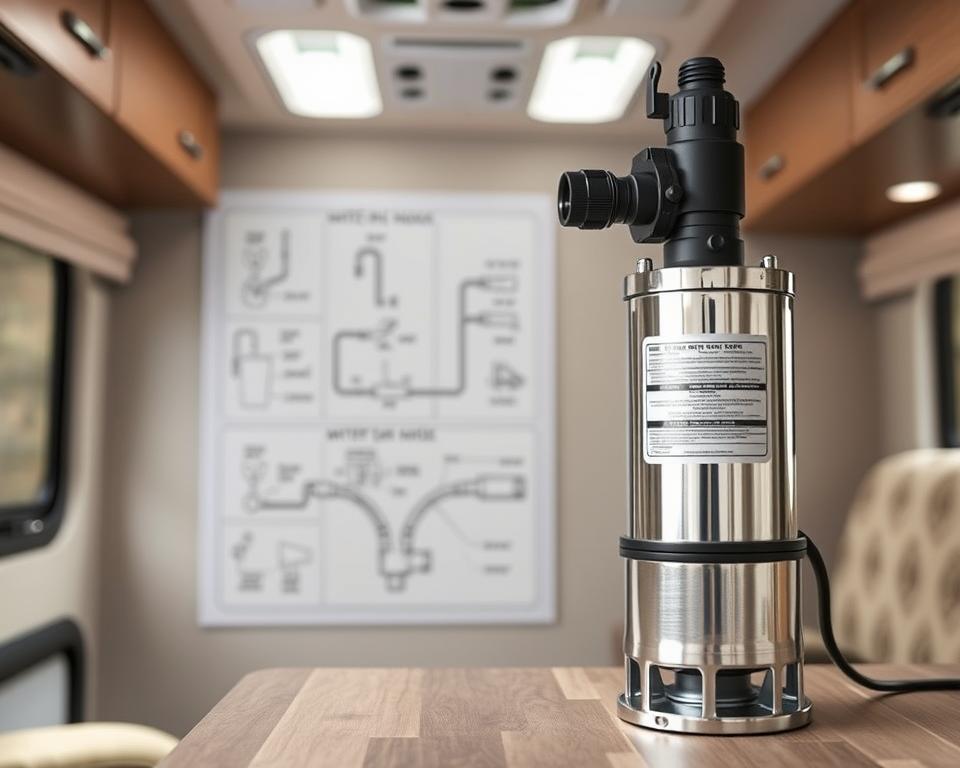RV Black Water Tank Pump: Tips for Guidance and Upkeep
Thinking about your RV adventures, have you pondered the importance of the black water tank pump? A crucial aspect of your RV’s hygiene system is the black water tank pump. Seamless travel depends on the correct maintenance of this pump. This guide will give you the important information you need to manage your RV waste water pump. If you understand its importance, you can optimize its performance and have even better RV experiences.
Main Points
- The RV black water tank pump is crucial for effective waste management.
- Regular maintenance can prolong the lifespan of your RV waste water pump.
- Understanding system components improves troubleshooting skills.
- Safe dumping practices are essential for both hygiene and the environment.
- Proper winterization of your RV black water tank system can save you money on repairs.
- By ensuring your RV sanitation pump is clean, you can reduce the occurrence of clogs and odors.
RV Water Tanks: An Overview
Perhaps many RV owners haven’t fully understood the importance of having different water tanks for a seamless camping experience with pump for RV holding tank. The functions of the RV fresh water, gray water, and black water tanks are important to be aware of. Each plays a unique role and needs proper care.
Drinkable water is stored in the RV fresh water tank. It’s used for drinking, cooking, and hygiene. The cleanliness of this tank and the safety of the water are extremely important. Fresh water is crucial for hydration and health during travels.
Sinks and showers in your RV drain into the gray water tank. Frequent checks and draining are necessary because this tank can fill up quickly. Proper gray water tank management is essential for a clean RV living space.
This RV black water tank is crucial as it contains toilet waste. Regular attention is needed to prevent smells and the accumulation of waste in this tank. The condition of the tank and your experience can be enhanced by using suitable tank chemicals. Knowing how to care for each tank makes RV trips more enjoyable.
Defining the RV Black Water Tank Pump
Recreational vehicle sanitation systems rely heavily on the RV black water tank pump. The pump’s function is to move waste to the appropriate disposal areas. If you know how it operates, you can maintain it better and avoid costly repairs.
Among the options for RV owners is the sewer pump, which is one type of pump. Due to its ability to grind waste and thus make disposal quicker, the macerator pump is a popular choice. This feature is very helpful at dump stations that are busy.
The key to good waste management in an RV is a quality black tank pump. This pump contributes to a clean and comfortable environment inside the RV. Regular checks and understanding how your pump functions will help you improve your RV experience.
Black Water Tank System Components: An Overview
For effective waste management, it’s vital to understand the RV black water tank system. For the system to function correctly, it relies on many essential components working together. Holding the waste from the RV’s toilet, the black water tank is the most important part. Made of sturdy materials, it’s designed to endure various conditions.

A significant function of the system’s pump is to move waste to a designated disposal area. This component is absolutely necessary for RV owners. Providing a flexible link between the tank and the dump station, sewer hoses are also very important. The design of these hoses prevents leaks and contains odors, which leads to a clean disposal process.
For the attachment of sewer hoses, which enables effective waste transfer, connection ports are essential. Termination valves are crucial for managing waste flow. During disposal, they stop waste from flowing backward and prevent spills, thus maintaining sanitation.
RV owners can efficiently maintain their sanitation system by learning about these key components. Knowing this is crucial for fixing problems while traveling or using the RV, which improves the whole RV experience.
Guidelines for Proper RV Black Water Tank Pump Usage
Knowing how to use the RV sanitation pump well greatly makes better your experience as an RV owner. Proper operation of the black tank is key to a system that runs efficiently. After each use, it’s critical to flush the tank thoroughly. It prevents the accumulation of solid waste, which could cause blockages and other issues.
Regularly inspecting your RV sanitation pump will ensure it’s functioning properly. This helps you avoid any bad situations when you’re traveling. It’s also crucial to use toilet paper that’s meant for RV use. Because it’s designed to break down quickly, this type of toilet paper reduces the risk of clogs.
Keeping the termination valves closed, except during emptying, is another vital practice. This will help keep the smells away. Using tank deodorants and cleaners will also help keep the system smelling good and clean. Adhering to these guidelines enhances your experience with the RV black water tank.
| Proper Black Tank Use Practices | Pros |
|---|---|
| Flush Using a Good Amount of Water | Stops clogs from solid waste |
| Make Sure to Regularly Check How the Pump Works | Guarantees it’s working properly |
| It’s Important to Use RV-Specific Toilet Paper | Reduces risk of blockages |
| Ensure the Termination Valves Remain Closed | Lowers the amount of odor |
| It’s Good to Use Tank Deodorizers and Cleaners | Maintains a clean and odor-free system |
Key Maintenance Advice for Your Black Water Tank Pump
It’s vital to maintain your RV’s black water tank pump regularly so it lasts longer and works efficiently. This means you need to use the correct chemical treatments that are designed for these types of tanks. They break down waste effectively and prevent odors.
Making sure there’s enough water when you use the toilet is also very important. By doing this, waste can move to the tank without problems, lowering the risk of it building up. Also, remember to clean the tank and all its parts thoroughly on a regular basis. Make sure you use the recommended tools for this task.
To avoid any issues, always check the levels in the tank. Deal with any leaks or overflows immediately. Make sure to empty the tank regularly to prevent solid waste accumulation. A maintenance schedule can help you avoid problems with your RV experience.
| Maintenance Item | Regularity | Explanation |
|---|---|---|
| Examine levels | On every journey | Make sure the tank isn’t too full to avoid leaks. |
| Use chemicals | Every time you empty it | Use treatments to help break down waste well. |
| Do a system flush | Monthly | Use a cleaning product to keep the tank clean. |
| Inspect the pump | Before any long travel | Inspect for any wear or damage so you don’t have breakdowns during your trip. |
| Dispose of tank contents | Depending on the need | When the tank gets full, make sure to empty it, ideally at the proper disposal sites. |
If you follow these important maintenance steps, your black water tank pump will work properly. This will enhance your RV trips significantly.
Common Black Water Tank Pump Issues and How to Solve Them
Fixing problems with the black tank pump can appear challenging. Many RV owners encounter various RV black tank problems such as clogs, leaks, or persistent odors. If you know how to deal with these problems early on, you can save time and money on repairs.
The first thing to do is check the hoses that are connected to the black tank pump. These areas are where blockages frequently happen, which causes the pump to not work well. Disconnect the hoses and check for buildup or debris. If there are any blockages, clean the hoses well before you connect them again.
After that, check the seals that are around the pump and the tank. Leaks can happen if the seals are damaged, and you might not realize it until there’s been a lot of damage. To prevent more issues, replace any seals that are damaged or not working correctly immediately.
Enzyme treatments can be helpful for odors that keep coming back. By breaking down the waste, these treatments help to reduce the bad smells. For the best outcome, make sure you follow the instructions from the manufacturer.
For your convenience, here’s a table summarizing common issues and how to solve them:
| Problem | Likely Cause | Solution |
|---|---|---|
| Clogs | Something stuck in the hoses or tank | Inspect and clean the hoses |
| Seepage | Seals that are broken | Make sure to inspect the seals and replace any that are damaged |
| Foul smells | Accumulation of waste | Use enzyme treatments |
| Pump isn’t functioning | Electrical problems | Inspect the connections and battery |
Recognizing the warning signs early on can prevent minor issues from turning into major problems with your RV black tank. By performing regular maintenance and being vigilant, you can extend the life of your black tank pump, which will improve your RV experience.
Best Ways to Clean Your RV Black Water Tank Pump
Maintaining a clean RV black water tank is crucial for both hygiene and the proper operation of its plumbing system. To reduce smells and make sure everything works well, try to rinse the tank with clean water after each use. This practice helps in reducing the buildup of waste and keeps the tank in good shape.
If you want to clean it more thoroughly, use cleaning products that are specifically designed for black water systems. They are effective in dissolving waste and combating odors. Fill the tank with water and cleaning solution, then let it soak. If your RV has a flush system that’s built in, it will make cleaning easier.
Making sharp turns or using sloshing techniques when you drive can help to agitate the contents of the tank. This helps to loosen any leftover material that’s stuck to the sides of the tank. These kinds of cleaning methods help the sensors work better, which can prevent problems related to sewage.
Ensuring Safe Dumping Procedures at RV Stations
Learning the right way to act at RV dump stations is key to keeping them nice for everyone. Once you arrive at a station, ensure your RV is positioned properly. Then, get your gear ready for dumping.
Follow these steps carefully to make sure the process goes well:
- Confirm that your sewer hose is firmly attached to the station’s connection point.
- Start by opening the black water valve to let the sewage flow out.
- Once the black tank is empty, close the valve. Then, open the gray water valve to clean the hose with the less dirty water.
- Once done, carefully remove your hose to prevent any spills.
- Be sure to always clean your hoses with water that’s safe to drink and then put them away immediately.
It’s also critical to follow local waste disposal laws. To protect the environment, many areas have rules that you are required to follow. If you don’t follow these rules, you could get fines or other penalties.
It’s important to be respectful at RV dump stations so that everyone has a better experience. By keeping the area tidy and sticking to the rules, you show care for the community. Such actions foster a culture of responsibility among RV enthusiasts and encourage eco-friendly camping habits.
Winter Preparation for Your RV Black Water Tank System
Winter preparation of your RV tanks is vital to protect the black water system from freezing. You need to prepare properly to avoid damage that can be caused by frozen water in the system. To make sure your RV black tank is effectively cared for in the winter, you need to follow specific steps.
- Begin by completely emptying the black water tank using the correct pump and connections.
- Following that, bypass the water heater to stop water from getting in and building up in the unit.
- Be sure to use RV antifreeze, because regular antifreeze can be toxic and can harm the environment. Pour the antifreeze into the system according to the product instructions.
- Make sure to leave all faucets and drains open so that any leftover water can get out and the antifreeze can circulate.
- Finally, check that all access panels are sealed and secure to prevent water intrusion during winter months.
Following these winterization steps allows RV owners to protect their black water tank systems from the severe impacts of winter. This kind of planning helps you avoid having to pay for expensive repairs or maintenance when the seasons change.
To Summarize
Efficient maintenance of the RV black water tank is very important for successful RV ownership. By becoming proficient with the black water tank pump and following the maintenance strategies in this guide, your travel experiences will be more enjoyable. By taking good care of your equipment, you’ll extend its life and simplify the process of managing waste in your RV. This makes travel less daunting.
Having knowledge about your RV’s black water system is key to addressing problems directly. If you use good maintenance, troubleshooting, and cleaning techniques, you can prevent unexpected problems. This lets you enjoy worry-free road trips. You can get extra help with your maintenance by using reputable services such as All in Sanitation. You can get the essential products and support for top-quality care from them.
To be a good RV owner, you need to be attentive and take proper care of all parts of your vehicle, including the black water tank. Having this information means you’re now ready to explore without any concerns. You’ve made all the right moves to guarantee an outstanding journey for yourself and others.

